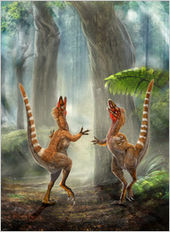That is what a team of Chinese and British scientists reported Wednesday in Nature, providing the first clear evidence of dinosaur colors from studies of 125-million-year-old fossils of a dinosaur called Sinosauropteryx.
"We might be able to start painting a picture in color of what these things looked like," said Lawrence M. Witmer, a paleontologist at Ohio University, who was not involved in the study.
Of course, such pictures have been painted many times, but the colors were products of a painter's imagination, not a scientist's laboratory.
Dinosaur fossils are mostly drab collections of mineralized bones. A few preserve traces of skin, and fewer still preserve structures that many scientists have argued are feathers.
In the new study, Michael Benton, a paleontologist at the University of Bristol, and colleagues have analyzed the structures of what appear to be feathers and say they match the feathers of living birds down to the microscopic level. They used microscopic features to determine the ancient feathers' color. The study builds on earlier work on fossil bird feathers by Jakob Vinther, a graduate student at Yale, and his colleagues. In 2006, Mr. Vinther discovered what looked like an ink sac preserved in a squid fossil. Putting the fossil under a microscope, he discovered the sac was filled with tiny spheres. The spheres were identical to pigment-loaded structures in squid ink, known as melanosomes.
Mr. Vinther knew that melanosomes created colors in other animals, including bird's feathers. He and his colleagues made a microscopic inspection of fossils of feathers from extinct birds. They discovered melanosomes with the same sausage-shaped structure as those found in living birds. By analyzing the shape and arrangement of the fossil melanosomes, they were able to get clues to their original color. They determined, for example, that a 47-million-year-old feather had the dark iridescent sheen found on starlings today.
Dr. Benton was intrigued when he read Mr. Vinther's research and immediately wondered what it might mean for dinosaurs.
Starting in the 1970s, a growing number of paleontologists argued that birds had evolved from a two-legged group of dinosaurs called theropods. The paleontologists pointed to traits in their skeletons found elsewhere only in birds. In 1996, Chinese paleontologists discovered an exquisitely preserved fossil of a miniature theropod, called Sinosauropteryx, that had whiskerlike structures on its head and back.
Some paleontologists argued that these whiskers were simple feathers. Skeptics have claimed that the structures were just shredded collagen fibers and that Sinosauropteryx had a smooth reptilian skin.
Since then, however, scientists have found a number of well-preserved theropod fossils with many more featherlike structures, corresponding to downy feathers and feathers with vanes. Scientists have even found bumps on the arm bones of dinosaurs, where the quills had attached. If all of these structures really were feathers, Dr. Benton reasoned, then they might have melanosomes. He and colleagues from the Institute of Vertebrate Paleontology and Paleoanthropology in Beijing set out to look for them in fossils of ancient birds and dinosaurs, including Sinosauropteryx.
The search was brief. "Essentially," Dr. Benton said, "wherever you look, you find it."
One of the dinosaurs Dr. Benton and his colleagues looked at, known as Sinornithosaurus, was a 125-million-year old squirrel-sized dinosaur covered in complex feathers. In a small sample of its fossil, the scientists found two types of melanosomes. One sort produces hues in birds ranging from gray to black; the other makes reddish tints.

One skeptic was not as impressed. Theagarten Lingham-Soliar of the University of KwaZulu-Natal in South Africa argued that the researchers should have investigated whether dinosaurs without so-called feathers also had melanosomes in their skin. "Regrettably, I have to say the study would not pass muster in college science," Dr. Lingham-Soliar said in an e-mail message.
Dr. Benton rejects such criticisms. "These filaments are feathers," he said. "They're not shredded tissue: they're stuffed with melanosomes."
The discovery also offers clues to the early prehistory of birds. Richard O. Prum, an evolutionary biologist at Yale and a collaborator with Mr. Vinther, has argued that Sinosauropteryx's whiskers represent an early stage in the evolution of feathers.
"It's an important advance to show that this dino fuzz really is feathers," Dr. Prum said.
Dr. Prum and Mr. Vinther are doing the same kind of research, examining dinosaur fossils for melanosomes.
Mr. Vinther said that the study published Wednesday did not have enough detail to provide a full-blown picture of a dinosaur's color patterns. "One or two samples is not going to do it," he said.




Reader Comments
to our Newsletter